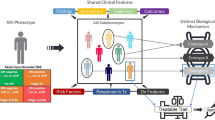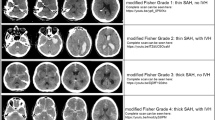Abstract
Aim of the study was the definition of a predictive model for the initial diagnosis of thrombotic microangiopathies (TMA). We retrospectively collected data on all adult patients admitted to the Gemelli Hospital from 2010 to 2014. ICD-9 codes from primary diagnoses were used for TMA diagnosis. Demographic and laboratory characteristics on admission of patients with TMA were then compared with a random sample of 500 patients with other diagnoses. The prediction model was externally validated in a cohort from another hospital. Overall, 23 of 187,183 patients admitted during the study period received a primary diagnosis of TMA. LDH (OR 1.26, 95% CI 1.05, 1.63) and platelets (OR 0.96, 95% CI 0.94, 0.98) were the only independent predictors of TMA. The AUROC of the final model including only LDH and platelets was 0.96 (95% CI 0.91, 1.00). The Hosmer–Lemeshow (HL) test (p = 0.54) suggested good calibration. Our model also confirmed good discriminatory power (AUROC 0.72 95% CI 0.60, 0.84) and calibration (HL test p = 0.52) in the validation sample. We present a simple prediction model for use in diagnosing TMA in hospitalized patients. The model performs well and can help clinicians to identify patients at high risk of TMA.




Similar content being viewed by others
References
George JN, Nester CM (2014) Syndromes of Thrombotic Microangiopathy. N Engl J Med 371:654–666. https://doi.org/10.1056/NEJMra1312353
Zheng X, Majerus EM, Sadler JE (2002) ADAMTS13 and TTP. Curr Opin Hematol 9:389–394. https://doi.org/10.1097/00062752-200209000-00001
McMinn JR, George JN (2001) Evaluation of women with clinically suspected thrombotic thrombocytopenic purpura-hemolytic uremic syndrome during pregnancy. J Clin Apher 16:202–209
Booth KK, Terrell DR, Vesely SK, George JN (2011) Systemic infections mimicking thrombotic thrombocytopenic purpura. Am J Hematol 86:743–751. https://doi.org/10.1002/ajh.22091
George JN (2011) Systemic malignancies as a cause of unexpected microangiopathic hemolytic anemia and thrombocytopenia. Oncol Williston Park N 25:908–914
Mannucci PM, Peyvandi F (2007) TTP and ADAMTS13: when is testing appropriate? Hematol Am Soc Hematol Educ Progr 2007:121–126. https://doi.org/10.1182/asheducation-2007.1.121
Garg AX, Suri RS, Barrowman N, Rehman F, Matsell D, Rosas-Arellano MP, Salvadori M, Haynes RB, Clark WF (2003) Long-term renal prognosis of diarrhea-associated hemolytic uremic syndrome: a systematic review, meta-analysis, and meta-regression. JAMA 290:1360–1370. https://doi.org/10.1001/jama.290.10.1360
Scully M, Yarranton H, Liesner R, Cavenagh J, Hunt B, Benjamin S, Bevan D, Mackie I, Machin S (2008) Regional UK TTP Registry: correlation with laboratory ADAMTS 13 analysis and clinical features. Br J Haematol 142:819–826. https://doi.org/10.1111/j.1365-2141.2008.07276.x
Noris M, Remuzzi G (2009) Atypical hemolytic-uremic syndrome. N Engl J Med 361:1676–1687. https://doi.org/10.1056/NEJMra0902814
George JN (2006) Thrombotic thrombocytopenic purpura. N Engl J Med 354:1927–1935. https://doi.org/10.1056/NEJMcp053024
Brunelli SM, Claxton A, Mehta S, Anum EA (2015) Consequences of hemolytic uremic syndrome among hemodialysis patients. J Nephrol 28:361–367. https://doi.org/10.1007/s40620-014-0149-x
Mead PS, Griffin PM (1998) Escherichia coli O157:H7. Lancet 352:1207–1212. https://doi.org/10.1016/S0140-6736(98)01267-7
Galbusera M, Noris M, Remuzzi G (2009) Inherited thrombotic thrombocytopenic purpura. Haematologica 94:166–170
Vande WJ, Delmas Y, Ardissino G, Wang J, Kincaid JF, Haller H (2016) Improved renal recovery in patients with atypical hemolytic uremic syndrome following rapid initiation of eculizumab treatment. J Nephrol. https://doi.org/10.1007/s40620-016-0288-3
Asif A, Nayer A, Haas CS (2017) Atypical hemolytic uremic syndrome in the setting of complement-amplifying conditions: case reports and a review of the evidence for treatment with eculizumab. J Nephrol 30:347–362. https://doi.org/10.1007/s40620-016-0357-7
Ruggenenti P, Noris M, Remuzzi G (2001) Thrombotic microangiopathy, hemolytic uremic syndrome, and thrombotic thrombocytopenic purpura. Kidney Int 60:831–846. https://doi.org/10.1046/j.1523-1755.2001.060003831.x
Crowther MA, George JN (2008) Thrombotic thrombocytopenic purpura: 2008 update. Cleve Clin J Med 75:369–375. https://doi.org/10.3949/ccjm.75.5.369
Galbusera M, Noris M, Remuzzi G (2006) Thrombotic thrombocytopenic purpura–then and now. Semin Thromb Hemost 32:81–89. https://doi.org/10.1055/s-2006-939763
Campistol Plana JM, Arias M, Ariceta Iraola G, Blasco M, Espinosa M, Grinyó JM, Praga Terente M, Torra Balcells R, Vilalta R, Rodríguez de Córdoba S (2013) Actualización en síndrome hemolítico urémico atípico: diagnóstico y tratamiento. Documento de consenso. Nefrol Publ Of Soc Esp Nefrol 33:27–45. https://doi.org/10.3265/Nefrologia.pre2012.Nov.11781
Acknowledgements
Gambaro and Ferraro designed the research; Gambaro, Ferraro, Lombardi, De Stefano, Zuppi, Bonelli, Buonocore, Cervellin and Lippi acquired the data; Ferraro and Lombardi performed the statistical analyses; Gambaro, Ferraro, Lombardi, De Stefano and Lippi drafted the paper; Zuppi, Bonelli, Buonocore, Cervellin, Naticchia and Sturniolo critically revised the paper; all the authors approved the final version of the manuscript.
Author information
Authors and Affiliations
Corresponding author
Ethics declarations
Conflict of interest
All the authors declare no conflict of interests.
Ethical approval
The study protocol was approved by the IRB of the Fondazione Policlinico Universitario A. Gemelli - Università Cattolica del Sacro Cuore, Rome.
Rights and permissions
About this article
Cite this article
Ferraro, P.M., Lombardi, G., Naticchia, A. et al. A STARD-compliant prediction model for diagnosing thrombotic microangiopathies. J Nephrol 31, 405–410 (2018). https://doi.org/10.1007/s40620-018-0468-4
Received:
Accepted:
Published:
Issue Date:
DOI: https://doi.org/10.1007/s40620-018-0468-4




